The prefecture of Magnesia occupies the east side of Thessaly, encompassing the peninsula of the same name, which ends in cape Trikeri and encloses the Pagasitic gulf in its embrace. Its boundaries extend to the Northern Sporades islands of Skiathos, Skopelos, Alonnissos.
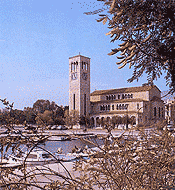 Among the fairest regions in Greece, Magnesia, crowned by superb Pelion, probably owes its name to the Magnetes tribe, who led by Magnes – son of Aiolos – inhabited the area in prehistoric times.
Among the fairest regions in Greece, Magnesia, crowned by superb Pelion, probably owes its name to the Magnetes tribe, who led by Magnes – son of Aiolos – inhabited the area in prehistoric times. 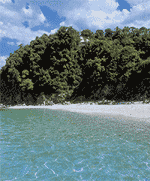 Travellers, however, who may find themselves taken unawares, carried away so much beauty, may find another unscientific derivation of the word more appropriate, as they find themselves “magnetlsed” by the place.
Travellers, however, who may find themselves taken unawares, carried away so much beauty, may find another unscientific derivation of the word more appropriate, as they find themselves “magnetlsed” by the place.
Much praised Pelion with its picturesque hamlets; Volos and its port, which holds out a promise to modern day Argonauts of travels full of surprises; gorgeous beaches, some tucked into wind-free coves, some disappearing into the infinite expanse of the Aegean, are only some of the delights hidden away in this corner of Greece.
Pine trees, oaks, firs, wild olive trees, chestnut trees and a myriad shrubs and plants – most of them with therapeutic properties – cover the mountains of Magnesia (Mts. Pelion, Tisaion, Orthris, Mavrovouni), which take up the greater portion of its surface, endowing it not only with unsurpassed loveliness, but also with wealth.
Magnesia is also renowned for its healthy climate; thanks to the beneficial effect of the sea surrounding it to the south and east it is blessed with mild winters and cool summers.
The shoreline formed by the large enclosed Pagasitic gulf and the Magnesia peninsula is somewhat broken up on the inner coast of the Pagasitic, while the coast facing the open sea is unindented.
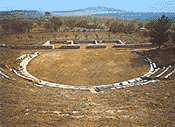 Another characteristic of the region that is most pronounced in Pelion is its advanced social attitude towards culture, which is revealed not only in the preservation of traditional houses but also in the locals’ effort to revive tradition in their customs and habits as well as in their arts and crafts. The high standard of folk art found in the museums as well as in shops is directly linked with the daily way of life in the region today.
Another characteristic of the region that is most pronounced in Pelion is its advanced social attitude towards culture, which is revealed not only in the preservation of traditional houses but also in the locals’ effort to revive tradition in their customs and habits as well as in their arts and crafts. The high standard of folk art found in the museums as well as in shops is directly linked with the daily way of life in the region today.
From the economic point of view the prefecture shows a balanced development of agriculture, industry – with the first car assembly plants in Greece; and tourism – with the on-going qualitative upgrading of infrastructure and services in this sector.
 Among the fairest regions in Greece, Magnesia, crowned by superb Pelion, probably owes its name to the Magnetes tribe, who led by Magnes – son of Aiolos – inhabited the area in prehistoric times.
Among the fairest regions in Greece, Magnesia, crowned by superb Pelion, probably owes its name to the Magnetes tribe, who led by Magnes – son of Aiolos – inhabited the area in prehistoric times.  Travellers, however, who may find themselves taken unawares, carried away so much beauty, may find another unscientific derivation of the word more appropriate, as they find themselves “magnetlsed” by the place.
Travellers, however, who may find themselves taken unawares, carried away so much beauty, may find another unscientific derivation of the word more appropriate, as they find themselves “magnetlsed” by the place.Much praised Pelion with its picturesque hamlets; Volos and its port, which holds out a promise to modern day Argonauts of travels full of surprises; gorgeous beaches, some tucked into wind-free coves, some disappearing into the infinite expanse of the Aegean, are only some of the delights hidden away in this corner of Greece.
Pine trees, oaks, firs, wild olive trees, chestnut trees and a myriad shrubs and plants – most of them with therapeutic properties – cover the mountains of Magnesia (Mts. Pelion, Tisaion, Orthris, Mavrovouni), which take up the greater portion of its surface, endowing it not only with unsurpassed loveliness, but also with wealth.
Magnesia is also renowned for its healthy climate; thanks to the beneficial effect of the sea surrounding it to the south and east it is blessed with mild winters and cool summers.
The shoreline formed by the large enclosed Pagasitic gulf and the Magnesia peninsula is somewhat broken up on the inner coast of the Pagasitic, while the coast facing the open sea is unindented.
 Another characteristic of the region that is most pronounced in Pelion is its advanced social attitude towards culture, which is revealed not only in the preservation of traditional houses but also in the locals’ effort to revive tradition in their customs and habits as well as in their arts and crafts. The high standard of folk art found in the museums as well as in shops is directly linked with the daily way of life in the region today.
Another characteristic of the region that is most pronounced in Pelion is its advanced social attitude towards culture, which is revealed not only in the preservation of traditional houses but also in the locals’ effort to revive tradition in their customs and habits as well as in their arts and crafts. The high standard of folk art found in the museums as well as in shops is directly linked with the daily way of life in the region today.From the economic point of view the prefecture shows a balanced development of agriculture, industry – with the first car assembly plants in Greece; and tourism – with the on-going qualitative upgrading of infrastructure and services in this sector.
Pelion
Pelion, land of the legendary Centaurs, the site chosen by the ancient gods for their weddings and celebrations, rises in lush magnificence to the northeast of Volos.
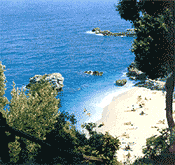 It was here that the centaur Chiron, the wise teacher of demigods and heroes, gave his pupils daily instruction in the proper care of body and soul. Here, too, the first beauty contest took place between Thetis and Eris.
It was here that the centaur Chiron, the wise teacher of demigods and heroes, gave his pupils daily instruction in the proper care of body and soul. Here, too, the first beauty contest took place between Thetis and Eris.
 “Many leaved” Pelion was an inspiration to Homer, Pindar and Euripides but also to the more modern popular muse who sung of the unquenchable desire of the Greek people for freedom.
“Many leaved” Pelion was an inspiration to Homer, Pindar and Euripides but also to the more modern popular muse who sung of the unquenchable desire of the Greek people for freedom.
The highest peaks of Pelion (Pliasidi, 1.548 m., Pourianos Stavros, 1,610 m.) are in the northern part of the range. Its inaccessible eastern flank, with the Aegean stretching out into the distance like a vast mirror, comes to an abrupt end in the sea, creating wildly beautiful rocky shores. Conversely, the tranquil, calm coast of the western flank on the Pagasitic gulf is much easier to reach and encourages shipping activity.
Pelion’s picturesque villages, sometimes clinging to wooded slopes or perched on steep bluffs, sometimes hidden away in verdant ravines, are so much a part of the scenery that, seen from a distance they create the impression of having “sprouted up” along with the trees.
 The distinctive traditional architecture of the old houses with their narrow windows and decorated walls, stone stairways and roofs of grey or greeny slate; the Byzantine churches with wonderful wall paintings and icon screens; the winding cobbled paths, sculpted fountains, courtyards redolent of basil and gardenia; squares paved with huge flag stones where the cheerful bubbling of a little brook is never absent – are all typical features of a Pelion village.
The distinctive traditional architecture of the old houses with their narrow windows and decorated walls, stone stairways and roofs of grey or greeny slate; the Byzantine churches with wonderful wall paintings and icon screens; the winding cobbled paths, sculpted fountains, courtyards redolent of basil and gardenia; squares paved with huge flag stones where the cheerful bubbling of a little brook is never absent – are all typical features of a Pelion village.
 It was here that the centaur Chiron, the wise teacher of demigods and heroes, gave his pupils daily instruction in the proper care of body and soul. Here, too, the first beauty contest took place between Thetis and Eris.
It was here that the centaur Chiron, the wise teacher of demigods and heroes, gave his pupils daily instruction in the proper care of body and soul. Here, too, the first beauty contest took place between Thetis and Eris. “Many leaved” Pelion was an inspiration to Homer, Pindar and Euripides but also to the more modern popular muse who sung of the unquenchable desire of the Greek people for freedom.
“Many leaved” Pelion was an inspiration to Homer, Pindar and Euripides but also to the more modern popular muse who sung of the unquenchable desire of the Greek people for freedom.The highest peaks of Pelion (Pliasidi, 1.548 m., Pourianos Stavros, 1,610 m.) are in the northern part of the range. Its inaccessible eastern flank, with the Aegean stretching out into the distance like a vast mirror, comes to an abrupt end in the sea, creating wildly beautiful rocky shores. Conversely, the tranquil, calm coast of the western flank on the Pagasitic gulf is much easier to reach and encourages shipping activity.
Pelion’s picturesque villages, sometimes clinging to wooded slopes or perched on steep bluffs, sometimes hidden away in verdant ravines, are so much a part of the scenery that, seen from a distance they create the impression of having “sprouted up” along with the trees.
 The distinctive traditional architecture of the old houses with their narrow windows and decorated walls, stone stairways and roofs of grey or greeny slate; the Byzantine churches with wonderful wall paintings and icon screens; the winding cobbled paths, sculpted fountains, courtyards redolent of basil and gardenia; squares paved with huge flag stones where the cheerful bubbling of a little brook is never absent – are all typical features of a Pelion village.
The distinctive traditional architecture of the old houses with their narrow windows and decorated walls, stone stairways and roofs of grey or greeny slate; the Byzantine churches with wonderful wall paintings and icon screens; the winding cobbled paths, sculpted fountains, courtyards redolent of basil and gardenia; squares paved with huge flag stones where the cheerful bubbling of a little brook is never absent – are all typical features of a Pelion village.
Volos
Volos (326 km. from Athens, 215 km. from Thessaloniki) is the capital and economic center of the prefecture. Thanks to its privileged position at the foot of Mt. Pelion on the Pagasitic gulf, it is a good base for enjoying the sea, wooded slopes and green valleys that surround it.
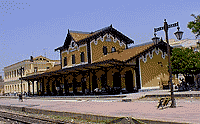 As for the derivation of the word “Volos”, which according to a Byzantine historian of the 14th century was called “Golos”, there are several theories; the most widely accepted is that it represents a corruption of the Mycenaean Iolkos.
As for the derivation of the word “Volos”, which according to a Byzantine historian of the 14th century was called “Golos”, there are several theories; the most widely accepted is that it represents a corruption of the Mycenaean Iolkos.
 Founded in the mid 19th century, modern Volos, with 71,000 inhabitants, is a cheerful, lively town, soundly laid out with pleasant broad streets.
Founded in the mid 19th century, modern Volos, with 71,000 inhabitants, is a cheerful, lively town, soundly laid out with pleasant broad streets.
The waterfront is an ideal spot for a stroll. A modern coastal avenue bustling with life, it is lined with pastry shops, cafes and restaurants.
From the suburb of Ano Volos, built up the slopes of Pelion, the Pagasitic gulf and the town below take on another dimension.
Volos harbour is a particularly active. It is the main export center of Thessaly and the scene of much commercial and passenger traffic bound for the Sporades, the great ports of the Mediterranean, Syria and other Middle Eastern cities.
 As for the derivation of the word “Volos”, which according to a Byzantine historian of the 14th century was called “Golos”, there are several theories; the most widely accepted is that it represents a corruption of the Mycenaean Iolkos.
As for the derivation of the word “Volos”, which according to a Byzantine historian of the 14th century was called “Golos”, there are several theories; the most widely accepted is that it represents a corruption of the Mycenaean Iolkos. Founded in the mid 19th century, modern Volos, with 71,000 inhabitants, is a cheerful, lively town, soundly laid out with pleasant broad streets.
Founded in the mid 19th century, modern Volos, with 71,000 inhabitants, is a cheerful, lively town, soundly laid out with pleasant broad streets.The waterfront is an ideal spot for a stroll. A modern coastal avenue bustling with life, it is lined with pastry shops, cafes and restaurants.
From the suburb of Ano Volos, built up the slopes of Pelion, the Pagasitic gulf and the town below take on another dimension.
Volos harbour is a particularly active. It is the main export center of Thessaly and the scene of much commercial and passenger traffic bound for the Sporades, the great ports of the Mediterranean, Syria and other Middle Eastern cities.

